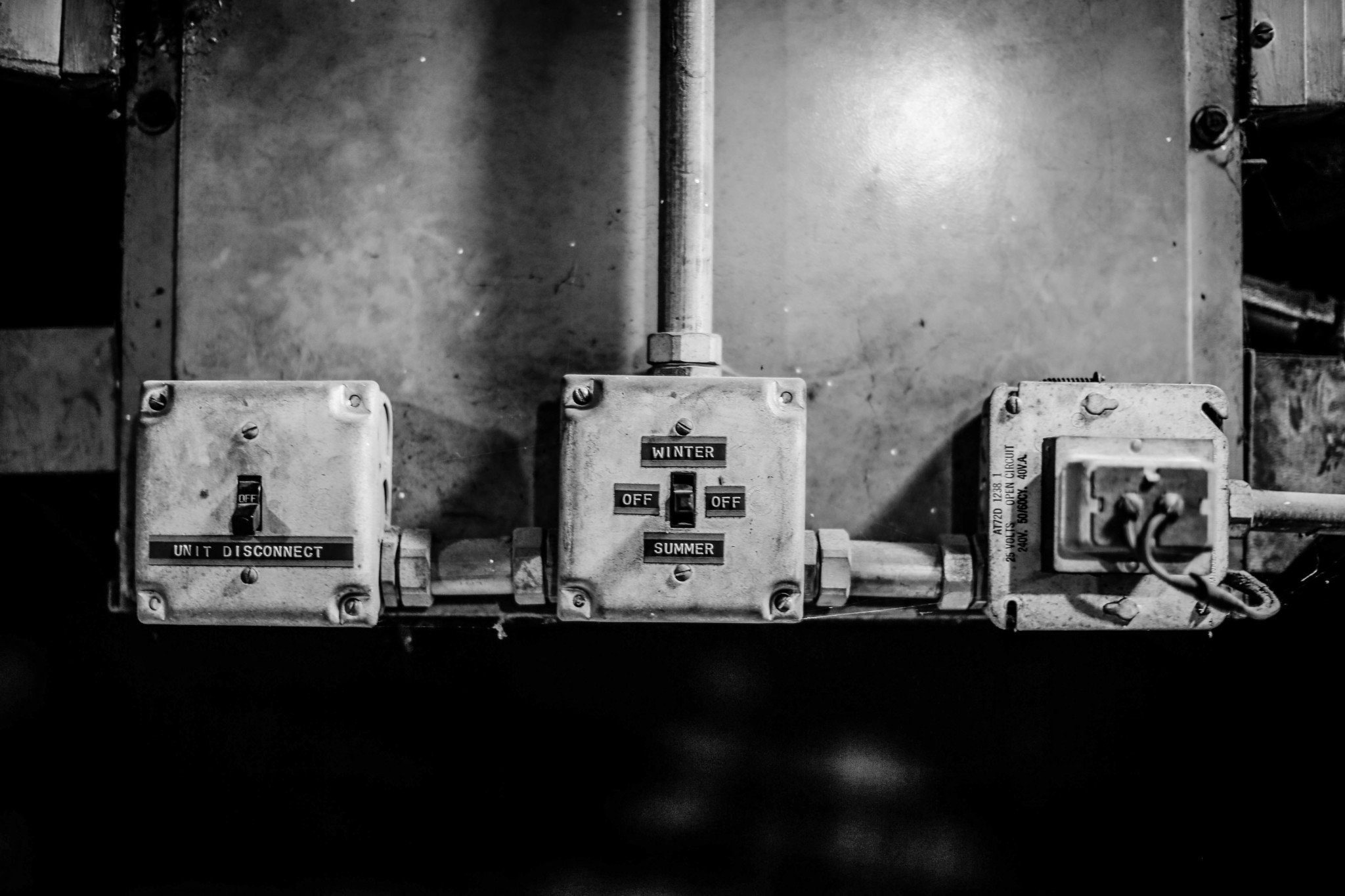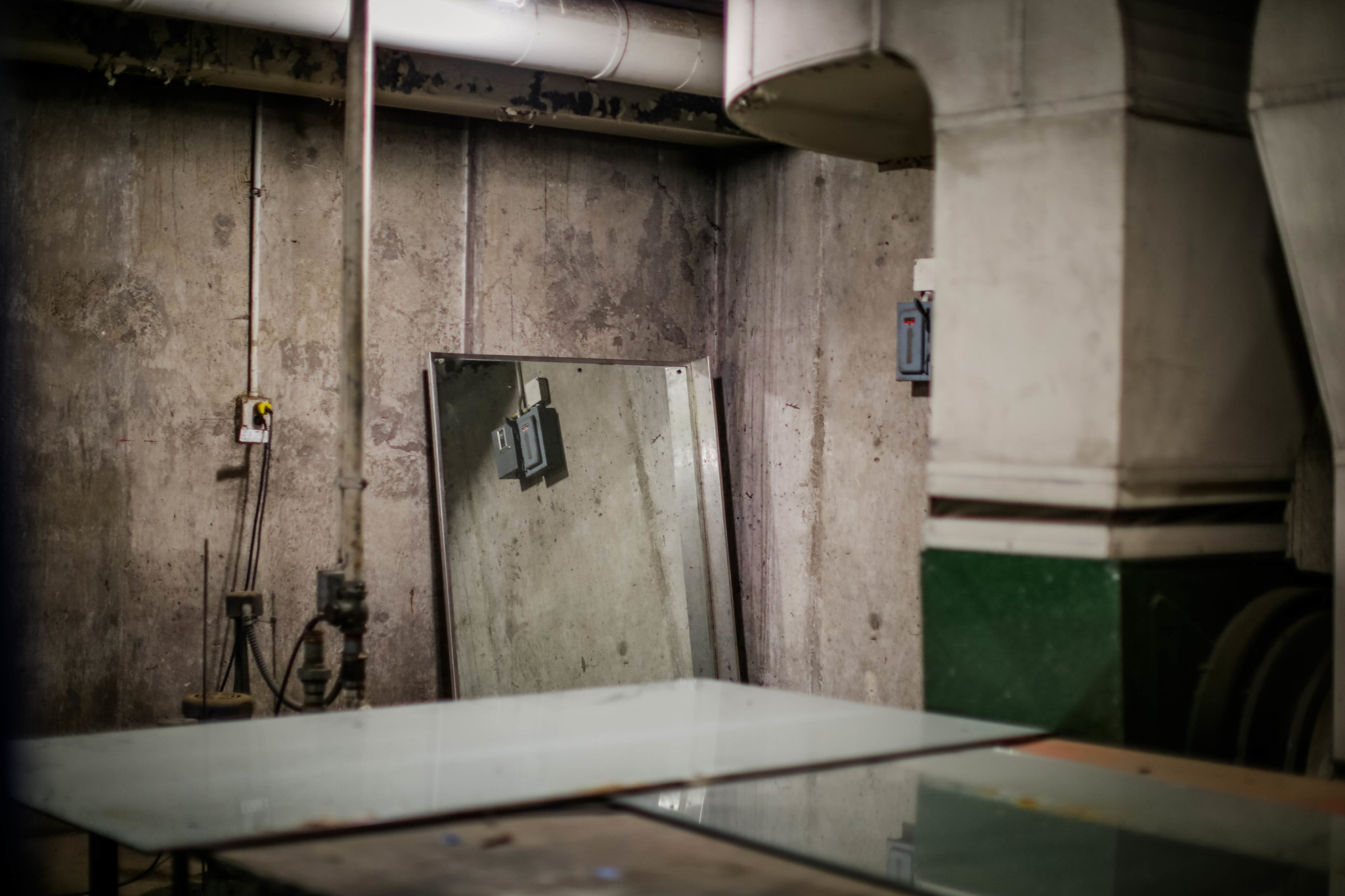Nothing in the facade of the fire station at the intersection of 55th and University Avenue betrays the location, underneath the firehouse, of a Cold War–era bomb shelter. All functioning bomb shelters are alike, but each decommissioned shelter was decommissioned in its own way. This one turned into a gym.
You can access it via two sets of stairs, one on each side of the firetruck garage. The staircase is lined with white square tiles that make it feel like a tunnel to an underground swimming pool. Halfway down the stairs, a door opens to a mini basketball court with just one hoop. The temperature drops noticeably as you descend. At the bottom, through the frame where a heavy metal door once stood, is a spacious rectangular compartment filled with sepulchral silver light.
The basement has the shape and proportions of a capital U and is equipped with a special telephone line. Unused office furniture, cardboard boxes, and extra pieces of firefighting gear are stored in smaller rooms on one side of the hallway. Parts of a complicated air ventilation system, which would have filtered contaminated, post–nuclear event air, pop up here and there: a low shaft along the wall, multiple grates, and lots of tubing. The inner part of the U contains a courtyard of sorts—a small open chamber used for draining the water from the fire engine above it.
Fallout shelters were designed to house as many occupants as possible. Before this one was decommissioned, its two compartments would have resembled army barracks. Much of the space not taken up by beds would have been used for storing supplies. Government nutritionists determined that that crackers would be the best way to stock large amounts of durable calories, so they came packed in boxes weighing a standard forty pounds bearing the unappetizing logo of the Office of Civil Defense. First aid kits and essential medicine came in special boxes that were stored in the darkest, driest corners of the shelter. It would have also been equipped with particle detectors to measure background radiation.
A motley assortment of workout gear now occupies most of the airy room. There’s a single narrow path between various bits of equipment, past bench presses inclined at various angles, racks, pulleys and pull-up bars. A heavy bag is suspended over a training mat on the far side. There’s even an indoor pop-up golf unit set up around the corner. If music is playing, its echo is deep and dull as it reverberates against the thick concrete walls.
The fallout shelter is not the only Cold War remnant in Hyde Park.
Only a short walk from the fire station, on the UofC campus, Enrico Fermi carried out the first ever sustained artificial nuclear chain reaction on December 2, 1942, ushering in the nuclear age. Today, Henry Moore’s sculpture Nuclear Energy stands to mark the location of Fermi’s discovery and to commemorate the event in all its multiple ambiguities.
At a distance, the sculpture’s shape is hard to make out. A closer look reveals a globe, suspended on thick, curvy columns. Get even closer and the shapeshifting monument starts to look like a mushroom cloud frozen in time. At a certain angle, it takes the shape of a hollowed-out skull. The brown of the bronze, seen against the overcast sky, takes on a crimson hue.
The parts of Jackson Park that protrude into Lake Michigan were once part of an air defense system. Parts of the park’s Promontory Point were fenced in, and inside, three radar towers stood side by side with globular radars on top. They monitored the sky above Chicago and were supposed to guide Nike missiles towards an incoming warhead. In the southern part of the park, near the triangular ledge, the remnants of the abandoned underground silos, where missiles were kept in peacetime, are still visible.
By the late 1960s, Nike missiles were considered too slow to counteract newer, more advanced warheads that were harder to detect and intercept. The Department of Defense began decommissioning them around the country, including the ones on the South Side. By 1971 the radar towers were torn down.
By then, public fallout shelters were being decommissioned too. Civil defense had always been a touchy subject, controversial in both its conception and its execution. The initial spending boom had come during the Kennedy administration, when the possibility of a nuclear war with the Soviet Union became much more real.
Throughout the Cold War era, the Office of Civil Defense was tasked with preparing the nation for the worst. It duly compiled reports, conducted assessments, and articulated scenarios that spelled out the myriad ways nuclear war might threaten the United States. For some time, in the planning race of the early sixties, shelters seemed like a way to move from the grim, dichotomous mantra of the time, “Better Dead Than Red,” to the much more palatable “Neither Dead Nor Red,” as political scientist Andrew Grossman put it.

But optimism faded once the public got a taste of what shelters actually were. The disparity between the risk—an H-bomb falling in your district, firestorm and fallout as far as the eye can see—and the supposed protection against it, government issued crackers and a barn repurposed as a shelter with an extra layer of wood, was hard to ignore.
Large industrial cities like Chicago, expecting to be in the direct line of fire, had to worry about the blast before they planned for the fallout. On August 23, 1961, the Tribune ran a story explaining what would happen if an atom bomb were dropped on the Loop. “If a ten megaton bomb struck at State and Madison streets,” the first paragraph reads, “It would leave a crater 200 feet deep and a half mile wide. The crater would run as far north as Lake street, as far south as Jackson boulevard, as far east as the Illinois Central railroad tracks, and as far west as La Salle street.” Within the four-mile area only those in shelters a thousand feet underground would survive.
Civil defense officials turned to the only possible way to survive nuclear bombing in Chicago—not to be in there when it happened—and tried to spin it as a strategy. The evacuation plan envisioned a quick and total exodus of Chicago’s population to the nearby suburbs. Not only did the plan necessitate ample warning time before the detonations, an obvious impossibility, it also required the availability and effective allocation of food and shelter to temporarily house and feed millions of fleeing residents in the suburbs.
With most questions left unanswered, and largely ignoring the question of protection from the nuclear explosion itself, Chicago began the weary work of repurposing basements and sheds and barns as fallout shelters. The city lifted the ban on the construction of personal shelters in late 1961, hoping that more prudent residents would willingly carry some of the burden. The Office of Civil Defense surveyed public buildings like schools and churches to find facilities that could be reinforced as cheaply as possible.
It is likely that the basement of the fire station on 55th was discovered during one such survey of the South Side sometime in the early 1960s. Now that the basement has gone full circle, it’s a testament to how civil defense plans were designed that neither the date of its initial designation nor of its eventual decommissioning can be recovered. Fallout shelters are much less complex than blast shelters; the latter must withstand the detonation of megatons of nuclear power while the former needs only to keep nuclear fallout out. As a result, designations often changed overnight and shelters cropped up like mushrooms to meet capacity quotas. Funding slowly trickled in for stocking essentials and infrastructural upgrades.
Shelter space was always limited and its allocation unequal. While most fallout shelters were little more than well-stocked basements with marginally thicker walls, taxpayer money also paid for ultra-secure, almost lavish shelters reserved for elites in the government and military. For example, O’Hare Inn had a shelter with a capacity of five hundred guests for itinerant businessmen. The distribution of shelters often seemed to be guided not by strategy and tactics but by privilege and triage.
Most fallout shelters, even if well maintained, have a short lifespan. Ever advancing weaponry, such as newer and more sophisticated nuclear warheads and hydrogen bombs with ever-increasing destructive power, created an evolutionary arms race between bombs and defense infrastructure. For the United States to have a viable civil defense infrastructure, it had to be building and upgrading shelters nearly constantly. The impossibility of such an undertaking, as well as mobilized opposition, both within the government and among the general public, led to the abandonment of ambitious civil defense plans. It left behind a graveyard of shelters and anti-aircraft infrastructure, both of which can be found on the South Side.
If the radars at Promontory Point and around the country had detected incoming warheads, they would have automatically triggered an emergency alert system that Chicagoans would have heard on the street, over the radio, and on TV. Those lucky enough to have access to blast shelters would have headed to in the nearest one. Those with family shelters would have gathered their families and braced for impact. The more informed would have turned to fallout shelters they knew and hoped that the blast would happen far enough away. The vast majority of citizens would have been unprepared or unable to locate or reach a shelter.
The shelter on 55th would likely have been overcrowded within minutes. The two chambers would have resembled an overflowing emergency room in a field hospital. The storage rooms along the hallway would have been filled to the brim with supplies. Government-issued guidebooks would have informed the occupants on how to measure background radiation, allocate portions of food and water, and communicate with the world outside.
The exact capacity is hard to estimate, but shelters of this size were expected to house more than two hundred for up to a week. But despite the stream of pamphlets and communications offering tidy solutions to unthinkable breakdowns of order, the one question that was never satisfactorily answered, what was to be done if more people showed up than the shelter could have housed.
Support community journalism by donating to South Side Weekly


Great writing, illuminates a topic that is very distressing to think about. If anyone wants to push this nuclear paranoia feeling to the max, the BBC film Threads is a “great” choice.
Would be just like the last event- we would have ordered food and fed them anyway probably.